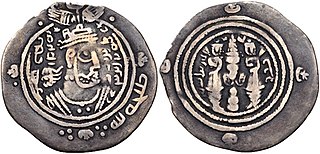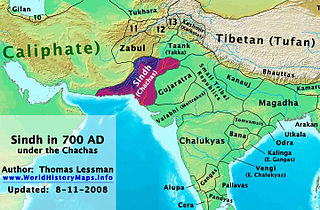
The Umayyad Caliphate or Umayyad Empire was the second caliphate established after the death of the Islamic prophet Muhammad and was ruled by the Umayyad dynasty. Uthman ibn Affan, the third of the Rashidun caliphs, was also a member of the clan. The family established dynastic, hereditary rule with Mu'awiya I, the long-time governor of Greater Syria, who became caliph after the end of the First Fitna in 661. After Mu'awiya's death in 680, conflicts over the succession resulted in the Second Fitna, and power eventually fell to Marwan I, from another branch of the clan. Syria remained the Umayyads' main power base thereafter, with Damascus as their capital.

Mu'awiya I was the founder and first caliph of the Umayyad Caliphate, ruling from 661 until his death. He became caliph less than thirty years after the death of the Islamic prophet Muhammad and immediately after the four Rashidun ('rightly-guided') caliphs. Unlike his predecessors, who had been close, early companions of Muhammad, Mu'awiya was a relatively late follower of Muhammad.

Muḥammad ibn al-Qāsim al-Thaqafī was an Arab military commander in service of the Umayyad Caliphate who led the Muslim conquest of Sindh, inaugurating the Umayyad campaigns in India. His military exploits led to the establishment of the Islamic province of Sindh, and the takeover of the region from the Sindhi Brahman dynasty and its ruler, Raja Dahir, who was subsequently decapitated with his head sent to al-Hajjaj ibn Yusuf in Basra. With the capture of the then-capital of Aror by Arab forces, Muhammad ibn al-Qasim became the first Muslim to have successfully captured Indian land, which marked the beginning of Muslim rule in South Asia.

Marwan ibn al-Hakam ibn Abi al-As ibn Umayya, commonly known as Marwan I, was the fourth Umayyad caliph, ruling for less than a year in 684–685. He founded the Marwanid ruling house of the Umayyad dynasty, which replaced the Sufyanid house after its collapse in the Second Fitna and remained in power until 750.

Ubayd Allah ibn Ziyad was the Umayyad governor of Basra, Kufa and Khurasan during the reigns of caliphs Mu'awiya I and Yazid I, and the leading general of the Umayyad army under caliphs Marwan I and Abd al-Malik.

Abu al-Mughira Ziyad ibn Abihi, also known as Ziyad ibn Abi Sufyan, was an administrator and statesman of the successive Rashidun and Umayyad caliphates in the mid-7th century. He served as the governor of Basra in 665–670 and ultimately the first governor of Iraq and practical viceroy of the eastern Caliphate between 670 and his death.

Samura ibn Jundab al-Fazārī was a companion of the Islamic prophet Muhammad who fought at the Battle of Uhud in 627 and later participated in the Muslim conquest of Iran in the 630s–640s. In 670–673 he served as the lieutenant governor of Basra under Ziyad ibn Abihi, the supreme governor of Iraq and the eastern Umayyad Caliphate. During his deputy rule over Basra, he is held by the Islamic traditional sources to have ordered wide-scale executions of Kharijites in his jurisdiction. He remained governor of Basra under the Umayyad caliph Mu'awiya I for six to eighteen months after Ziyad's death in August/September 673 until the Caliph replaced him.

The Umayyad Dynasty came to rule the Caliphate in 661 CE, and during the first half of the 8th century CE, a series of battles took place in the Indian subcontinent between armies of the Umayyad Caliphate and Indian kingdoms situated to the east of the Indus river, subsequent to the Arab conquest of Sindh in present-day Pakistan during 711 – 713 CE.
The Najdat were the sub-sect of the Kharijite movement that followed Najda ibn 'Amir al-Hanafi, and in 682 launched a revolt against the Umayyad Caliphate in the historical provinces of Yamama and Bahrain, in central and eastern Arabia.
Sind was an administrative division of the Umayyad Caliphate and later of the Abbasid Caliphate in post-classical India, from around 711 CE with the Umayyad conquest of Sindh by the Arab military commander Muhammad ibn al-Qasim, to around 854 CE with the emergence of the independent dynasties of the Habbarid Emirate and the Emirate of Multan. The "Governor of Sind" was an official who administered the caliphal province over what are now Sindh and South Punjab in Pakistan, with Makran in Balochistan also usually being under his control.
The Battle of Ayn al-Warda was fought in early January 685 between the Umayyad army and the Penitents (Tawwabin). The Penitents were a group of pro-Alid Kufans led by Sulayman ibn Surad, a companion of Muhammad, who wished to atone for their failure to assist Husayn ibn Ali in his abortive uprising against the Umayyads in 680. Pro-Alid Kufans had urged Husayn to revolt against the Umayyad caliph Yazid but then failed to assist him when he was killed in the Battle of Karbala in 680. Initially a small underground movement, the Penitents received widespread support in Iraq after the death of Yazid in 683. They were deserted by most of their supporters shortly before the departure to northern Syria where a large Umayyad army under the command of Ubayd Allah ibn Ziyad was preparing to launch an assault on Iraq. In the three-day long battle that ensued at Ras al-Ayn, the small Penitent army was annihilated and its senior leaders, including Ibn Surad, were killed. Nevertheless, this battle proved to be a forerunner and source of motivation for the later more successful movement of Mukhtar al-Thaqafi.
ʿAbbād ibn Ziyād ibn Abīhi was an Arab commander and statesman of the Umayyad Caliphate. A son of the governor of Iraq, Ziyad ibn Abihi, Abbad served as a governor of Sijistan between 673 and 681 under caliphs Mu'awiya I and Yazid I. He led a contingent in the army of Caliph Marwan I at the Battle of Marj Rahit and afterward fought against loyalists of al-Mukhtar al-Thaqafi during the reign of Caliph Abd al-Malik. He later served at the court of the latter's son and successor, Caliph al-Walid I, and played a role in the succession intrigues between al-Walid's son Abd al-Aziz and the caliph's brother, Sulayman.
ʿAbd al-Raḥmān ibn Ziyād ibn Abīhi was the Umayyad governor of Khurasan in 678/79–681. He is credited for reasserting Umayyad authority over the Arab tribesmen who garrisoned the province and ensuring the flow of Khurasan’s revenues and tribute to the Umayyad treasury in Damascus.
Busr ibn Abi Artat al-Amiri was a prominent Arab commander in the service of Mu'awiya I, the governor of Islamic Syria (640s–661) and the first Umayyad caliph (661–680). A veteran of the early Muslim conquests in Syria and North Africa, Busr became an ardent partisan of Mu'awiya against Caliph Ali during the First Muslim Civil War. He led a large-scale campaign against Ali's supporters in Arabia, gaining the submission of Medina, Mecca and Ta'if to Mu'awiya's caliphate and carrying out punitive measures against the inhabitants of Yemen. His actions in Arabia, which included executing two young sons of Ali's cousin, the governor of Yemen Ubayd Allah ibn Abbas, and taking captive women from the Muslim tribe of Hamdan, were condemned as unprecedented atrocities by the traditional Muslim sources, particularly Shia Muslim writers.
Sa'id ibn Uthman ibn Affan al-Umawi was an Umayyad general and military governor of Khurasan in 676–677 during the reign of Caliph Mu'awiya I. He was a son of Caliph Uthman and a one-time seeker of the caliphate in 675/76.
Qays ibn al-Haytham al-Sulamī was an Arab commander and administrator in the service of the Rashidun, Umayyad and Zubayrid caliphates. Under the caliphs Uthman and Mu'awiya I he served at time as the sub-governor of Khurasan and the cities of Nishapur and Marw al-Rudh. He was from a prominent Arab family in Basra and was a leader among the tribal nobility of that city until his death after 684.
Al-Hakam ibn Amr al-Ghifari, was a companion of the Islamic prophet Muhammad and the Umayyad governor of Khurasan and commander of Arab expeditions into Transoxiana from 665 until his death in Merv.

The Arab Empire maintained and expanded a wide trade network across parts of Asia, Africa and Europe. This helped establish the Arab Empire as the world's leading economic power throughout the 8th–13th centuries according to the political scientist John M. Hobson. It is commonly believed that Mu‘awiya Ibn Abi Sufyan was the first planner and establisher of the Islamic navy.
Zuṭṭ is an Arabicised form of Jat. Originally inhabitants of lower Indus Valley, Jats were present in Mesopotamia from the 5th century AD since the times of the Sasanian Empire, although their main migration occurred after the establishment of Umayyad Caliphate. They were one of the prominent ethnic groups in lower Iraq during the Islamic Golden Age, supplying mercenary soldiers to the Muslim states. Their mention fades from Arab chronicles after the 11th century.

Arabs had captured Sind and Multan in 712 AD after defeating Raja Dahir of Sind.The Arabs of Sind and Multan regularly tried to extend their sway over the adjoining territories. In 839 AD, Arabs lost fort Sindan to Mihira Bhoja.










